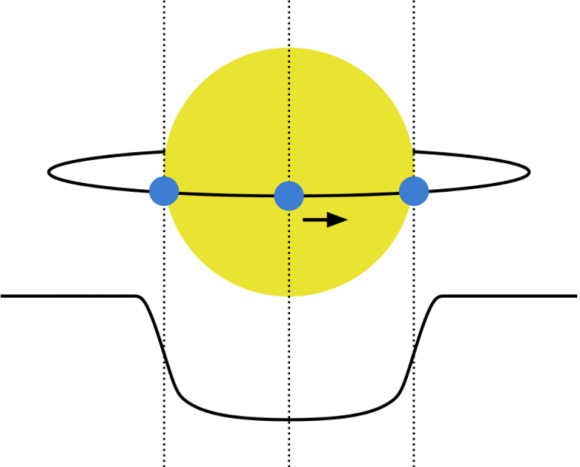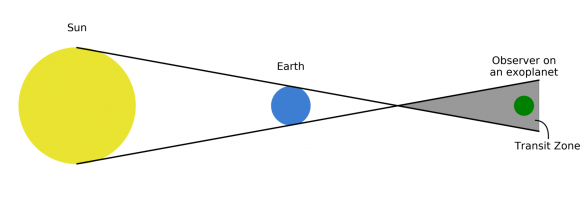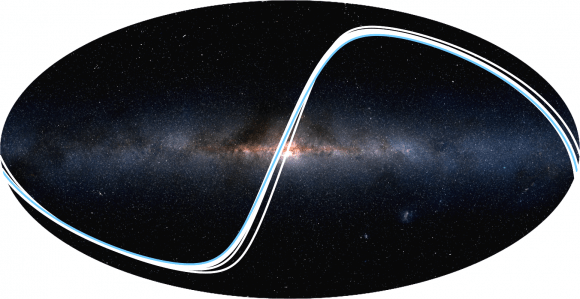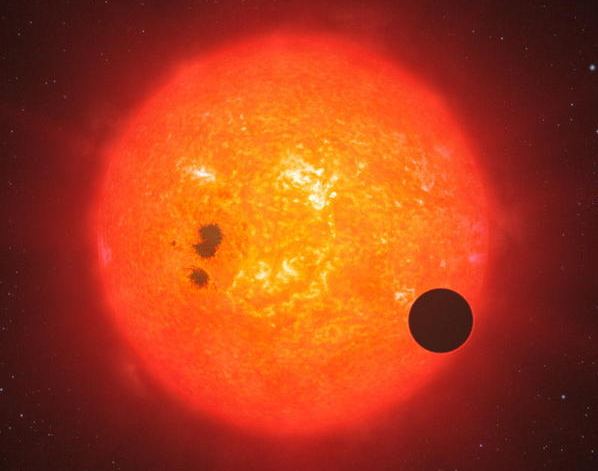In the past few decades, the search for extra-solar planets has turned up a wealth of discoveries. Between the many direct and indirect methods used by exoplanet-hunters, thousands of gas giants, rocky planets and other bodies have been found orbiting distant stars. Aside from learning more about the Universe we inhabit, one of the main driving forces behind these efforts has been the desire to find evidence of Extra-Terrestrial Intelligence (ETI).
But suppose there are ETIs out there that are are also looking for signs of intelligence other than their own? How likely would they be to spot Earth? According to a new study by a team of astrophysicists from Queen’s University Belfast and the Max Planck Institute for Solar System Research in Germany, Earth would be detectable (using existing technology) from several star systems in our galaxy.
This study, titled “Transit Visibility Zones of the Solar System Planet“, was recently published in the Monthly Notices of the Royal Astronomical Society. Led by Robert Wells, a PhD student at the Astrophysics Research Center at Queen’s University Belfast, the team considered whether or not Earth would be detectable from other star systems using the Transit Method.

This method consists of astronomers observing stars for periodic dips in brightness, which are attributed to planets passing (i.e. transiting) between them and the observer. For the sake of their study, Wells and his colleagues reversed the concept in order to determine if Earth would be visible to any species conducting observations from vantage points beyond our Solar System.
To answer this question, the team looked for parts of the sky from which one planet would be visible crossing the face of the Sun – aka. “transit zones”. Interestingly enough, they determined that the terrestrial planets that are closer to the Sun (Mercury, Venus, Earth and Mars) would easier to detect than the gas and ice giants – i.e. Jupiter, Saturn, Uranus and Neptune.
While considerably larger, the gas/ice giants would be more difficult to detect using the transit method because of their long-period orbits. From Jupiter to Neptune, these planets take about 12 to 165 years to complete a single orbit! But more important than that is the fact that they orbit the Sun at much greater distances than the terrestrial planets. As Robert Wells indicated in a Royal Astronomical Society press statement:
”Larger planets would naturally block out more light as they pass in front of their star. However the more important factor is actually how close the planet is to its parent star – since the terrestrial planets are much closer to the Sun than the gas giants, they’ll be more likely to be seen in transit.”

Ultimately, what the team found was that at most, three planets could be observed from anywhere outside of the Solar System, and that not all combinations of these three planets was possible. For the most part, an observer would see only planet making a transit, and it would most likely be a rocky one. As Katja Poppenhaeger, a lecturer at the School of Mathematics and Physics at Queen’s University Belfast and a co-author of the study, explained:
“We estimate that a randomly positioned observer would have roughly a 1 in 40 chance of observing at least one planet. The probability of detecting at least two planets would be about ten times lower, and to detect three would be a further ten times smaller than this.”
What’s more, the team identified sixty-eight worlds where observers would be able to see one or more of the Solar planets making transits in front of the Sun. Nine of these planets are ideally situated to observe transits of the Earth, though none of them have been deemed to be habitable. These planets include HATS-11 b, 1RXS 1609 b, LKCA 15 b, WASP-68 b, WD 1145+017 b, and four planets in the WASP-47 system (b, c, d, e).
On top of that, they estimated (based on statistical analysis) that there could be as many as ten undiscovered and potentially habitable worlds in our galaxy which would be favorably located to detect Earth using our current level of technology. This last part is encouraging since, to date, not a single potentially habitable planet has been discovered where Earth could be seen making transits in front of the Sun.

The team also indicated that further discoveries made by the Kepler and K2 missions will reveal additional exoplanets that have “a favorable geometric perspective to allow transit detections in the Solar System”. In the future, Wells and his team plan to study these transit zones to search for exoplanets, which will hopefully reveal some that could also be habitable.
One of the defining characteristics in the Search for Extra-Terrestrial Intelligence (SETI) has been the act of guessing about what we don’t know based on what we do. In this respect, scientists are forced to consider what extra-terrestrial civilizations would be capable of based on what humans are currently capable of. This is similar to how our search for potentially habitable planets is limited since we know of only one where life exists (i.e. Earth).
While it might seem a bit anthropocentric, it’s actually in keeping with our current frame of reference. Assuming that intelligent species could be looking at Earth using the same methods we do is like looking for planets that orbit within their star’s habitable zones, have atmospheres and liquid water on the surfaces.
In other words, it’s the “low-hanging fruit” approach. But thanks to ongoing studies and new discoveries, our reach is slowly extending further!


Isn’t Venus considered to be at least marginally in the solar system’s habitable zone? Unless these beings had something like the James Webb Space Telescope, which will be able to study exoplanets’ atmospheres, how would they be able to tell a Venus from an Earth?
Good question. Like us, they would be forced to make educated guesses and put constraints on Venus’ habitability. The same would hold true for Earth and Mars. In the end, they would probably conclude that Earth was the best bet, and that Venus and Mars were question marks.
Matt, you have become one of the most prolific UT contributors ever, and I always enjoy your well-written, open-minded articles on ETs.
Keep up the good work!
Thanks Jim! Glad you’re enjoying them 🙂
Speaking of Venus, another factor would be time.
We are Venus’ closest neighbor, but we have to wait over a century to see a transit(or 2).
This, to me, shows how many worlds out there are missing seeing us, as we miss seeing them, because of the many variables of orbital geometries.
It boggles the mind to think of what we will find when we are able to reach the “higher fruit”
Tony
Next time long distance space probes (like the Voyager, New Horizon, and more) are sent to their missions, why not give them one or more “bonus programs” ? Especially if more than one are sent on a mission were data are sent to earth in more than one decade, there should be time to look from different positions and see if there is more to detect than observers on earth can do.